Murchu
Well-known
both gordy and lance have custom length options without a price increase...
You definitely deserve a commission Joe, lol. In seriousness though, yours is a good endorsement of the lance strap & definitely need an option for a long strap.
At least here in the US, yes. The stuff I found in a local sewing / craft store is the same thickness as Gordy uses -- not sure if it is 2 ply or 4 ply though. Mine last 6 months to a year with moderate use before a strand frays and I replace it (if I was shooting every day it might only last 3-4 months), but since it takes literally 5 minutes to make up a handful, it doesn't bother me much to replace them regularly.
I think kokoshawnuff has an important point though. If your lugs are really worn, the edges are likely very sharp and they will knife through the thread very quickly.
Good to know. Yes, it is a good point re: sharp edges on lugs, and kinda leaning towards perhaps replacing the metal o-ring on the strap currently, with a piece of leather that would not rotate too much through the eye of the lug. Lugs not about to fail imminently, but definitely looking at a solution, as do not want to aggravate the damage any more, or especially risk anything that could lead to the camera taking a slide ground-bound..
Nomad Z
Well-known
Here's my home brew strap. (May need to click the pictures to see bigger versions.) It's made from 16mm black webbing and some black paracord. The webbing is fairly dense (it holds its shape well), while still being pretty soft and very flexible.
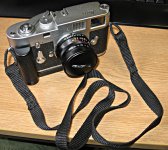
An overall view. As you can see, there are no buckles or adjusters. I chose this because I found that I had never adjusted my original home brew strap once I had the height set. What I didn't like about the original strap was that it was hard to get it off my wrist - the adjuster buckle things would catch on the loop of strap.
The basic construction is a fold of 2" or so at each end, and then two rows of stitching at the end, using very, very, ultra-very strong thread (looks more like thin string, made of polyester). Melt the trimmed ends of the webbing before stitching. To make sure the thread can't pull through, I make a triple knot - that's an overhand knot, followed by another two overhand knots enclosing the previous knots. Start the stitch inside the two layers of webbing so that a lump of knotted thread isn't sticking out. At the end, I do a few stitches on top of each other, and put the needle through only one layer of the webbing and do a single knot, pulled in so that it's inside the two layers. (Thus, the stitching does not go all the way to the melted end of the webbing - leave 2-3mm unstitched.)
Thumb through the loop, and a few good, hefty pulls on the webbing to see if anything comes away.
The paracord is melted at the ends and tweaked into a fairly narrow diameter while melting to make sure it can go through the strap lugs. I did this by giving it a little touch with the flame and then rolling the end between my fingers - a little touch means that there isn't much heat in it, and quick rolls with the fingers means you don't get burnt. Repeat several times to get the ends of the cord sealed.
The trick is to thread the cord through the strap lug, and through the loop in the strap, and then tie a knot in it. To make everything neat, the loose ends of the cord are fed up between the two layers of the webbing. For this to work, the majority of the loop needs to be turned into a little pocket, and I did this by running some stitching up the sides of the loop, stopping about 12-15mm short of the actual fold in the webbing (where the cord passes through).
You can see the stitching up the side here...
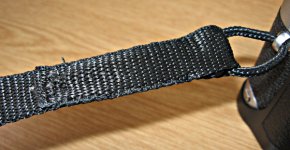
Note how the edge of the stiched loop opens up where the cord is. Also, note the grey bit of thread sticking out at the left hand end - the knot in the ultra strong thread is just inside the flap.
The knot in the paracord is a sheet bend. This is a knot that is primarily used for joining ropes of disimilar thicknesses, but works just as well for ropes of the same thickness. It is also quite a low profile knot, is easy to tie, and easy to adjust before it is finally tightened. You want to be able to adjust it so that you can set how much cord is exposed (similar to choosing a size of split ring).
The knot is tied with the cord through the lug and loop, with the webbing loop out to the side. Once tied, the lengths of the loose ends of the paracord are trimmed and re-melted if needed, to be sure that they will fit inside the little pocket at the end of the strap. (I used about 8" of cord per end, and only trimmed a little.) Try to get the melted ends to take on a taper shape - this will help the cord to feed into the pocket without catching on the fibres of the webbing. Ditto removing any sharp bits from the melted ends (trim with scissors). If the ends are too long, they won't go in (there isn't really any room to just stuff it all in - they have to lie straight). If it's too short, healthy paranoia states that one will worry that the thing will unravel.
So, trim to fit, work the knot into the open end of the pocket, and push the loose cord ends in. I found that pushing them in was a bit easier if I pressed the sides of the webbing pocket - it bowed up and made a cavity. Getting the first one in is easier than the second. Some fine tipped tweezers helped with the second one.
This last shot shows the profile of the strap...
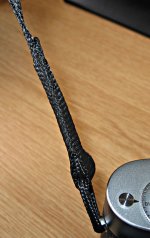
At the top is the single layer of webbing. For about the same length below that, there is the double layer of webbing where the ultra-strong thread is. After that, it thickens up a bit where the two loose ends of the paracord are. Finally, at the end, there is a small lump where the knot is inside the webbing.
The bulge at the knot is far smaller than the tri-glide adjusters I had used in my original home brew strap. So, much lower profile, and nothing catches when I've been using the strap round my wrist and want to take it off. It's also better when putting the camera in the bag - I always used to be careful how I did this to be sure that the adjusters were led away from the viewfinder (breakage paranoia). Now, I still run the strap the same way, but don't have to worry about buckles meeting glass.

An overall view. As you can see, there are no buckles or adjusters. I chose this because I found that I had never adjusted my original home brew strap once I had the height set. What I didn't like about the original strap was that it was hard to get it off my wrist - the adjuster buckle things would catch on the loop of strap.
The basic construction is a fold of 2" or so at each end, and then two rows of stitching at the end, using very, very, ultra-very strong thread (looks more like thin string, made of polyester). Melt the trimmed ends of the webbing before stitching. To make sure the thread can't pull through, I make a triple knot - that's an overhand knot, followed by another two overhand knots enclosing the previous knots. Start the stitch inside the two layers of webbing so that a lump of knotted thread isn't sticking out. At the end, I do a few stitches on top of each other, and put the needle through only one layer of the webbing and do a single knot, pulled in so that it's inside the two layers. (Thus, the stitching does not go all the way to the melted end of the webbing - leave 2-3mm unstitched.)
Thumb through the loop, and a few good, hefty pulls on the webbing to see if anything comes away.
The paracord is melted at the ends and tweaked into a fairly narrow diameter while melting to make sure it can go through the strap lugs. I did this by giving it a little touch with the flame and then rolling the end between my fingers - a little touch means that there isn't much heat in it, and quick rolls with the fingers means you don't get burnt. Repeat several times to get the ends of the cord sealed.
The trick is to thread the cord through the strap lug, and through the loop in the strap, and then tie a knot in it. To make everything neat, the loose ends of the cord are fed up between the two layers of the webbing. For this to work, the majority of the loop needs to be turned into a little pocket, and I did this by running some stitching up the sides of the loop, stopping about 12-15mm short of the actual fold in the webbing (where the cord passes through).
You can see the stitching up the side here...

Note how the edge of the stiched loop opens up where the cord is. Also, note the grey bit of thread sticking out at the left hand end - the knot in the ultra strong thread is just inside the flap.
The knot in the paracord is a sheet bend. This is a knot that is primarily used for joining ropes of disimilar thicknesses, but works just as well for ropes of the same thickness. It is also quite a low profile knot, is easy to tie, and easy to adjust before it is finally tightened. You want to be able to adjust it so that you can set how much cord is exposed (similar to choosing a size of split ring).
The knot is tied with the cord through the lug and loop, with the webbing loop out to the side. Once tied, the lengths of the loose ends of the paracord are trimmed and re-melted if needed, to be sure that they will fit inside the little pocket at the end of the strap. (I used about 8" of cord per end, and only trimmed a little.) Try to get the melted ends to take on a taper shape - this will help the cord to feed into the pocket without catching on the fibres of the webbing. Ditto removing any sharp bits from the melted ends (trim with scissors). If the ends are too long, they won't go in (there isn't really any room to just stuff it all in - they have to lie straight). If it's too short, healthy paranoia states that one will worry that the thing will unravel.
So, trim to fit, work the knot into the open end of the pocket, and push the loose cord ends in. I found that pushing them in was a bit easier if I pressed the sides of the webbing pocket - it bowed up and made a cavity. Getting the first one in is easier than the second. Some fine tipped tweezers helped with the second one.
This last shot shows the profile of the strap...

At the top is the single layer of webbing. For about the same length below that, there is the double layer of webbing where the ultra-strong thread is. After that, it thickens up a bit where the two loose ends of the paracord are. Finally, at the end, there is a small lump where the knot is inside the webbing.
The bulge at the knot is far smaller than the tri-glide adjusters I had used in my original home brew strap. So, much lower profile, and nothing catches when I've been using the strap round my wrist and want to take it off. It's also better when putting the camera in the bag - I always used to be careful how I did this to be sure that the adjusters were led away from the viewfinder (breakage paranoia). Now, I still run the strap the same way, but don't have to worry about buckles meeting glass.
PMCC
Late adopter.
My 2 cents: better to bite the bullet and replace the lugs and be done with it. Anything else is just kicking the can down the road. But suit yourself.
Murchu
Well-known
Here's my home brew strap.
Great writeup, cheers for posting your process and results!
My 2 cents: better to bite the bullet and replace the lugs and be done with it. Anything else is just kicking the can down the road. But suit yourself.
Not sure I get you. The way I see it, replacing the lugs and having a new set get worn down over time like this set is not solving the problem long term, whereas by finding a strap that will cause no wear will mean no need to replace the lugs..
ruby.monkey
Mentor
I suspect that he means you should have them replaced with steel lugs, which won't wear out in your lifetime.
Murchu
Well-known
I suspect that he means you should have them replaced with steel lugs, which won't wear out in your lifetime.
Ah, fair enough. Will the steel ones last this long though, as I have seen others who have gotten lugs replaced 3 or 4 times. To be honest, if I did get the lugs replaced at some point, it would definitely be with the steel ones.
Roger Hicks
Mentor
My 2 cents: better to bite the bullet and replace the lugs and be done with it. Anything else is just kicking the can down the road. But suit yourself.
Seconded. A worn lug will just saw through thread. Better new lugs than a smashed camera. And yes, steel lasts a LOT longer than brass.
Also, even brass lugs take decades to wear through (1-5, with plenty of use). How old are you?
Finally, you can see wear on a lug. On a thread...?
Cheers,
R.
Pablito
coco frío
Seconded. A worn lug will just saw through thread. Better new lugs than a smashed camera. And yes, steel lasts a LOT longer than brass.
Also, even brass lugs take decades to wear through (1-5, with plenty of use). How old are you?
Finally, you can see wear on a lug. On a thread...?
Cheers,
R.
yeah. I would never think of messing around with thread or string.
Nomad Z
Well-known
Finally, you can see wear on a lug. On a thread...?
Loose fibres would be a good indication, I would have thought.
Roger Hicks
Mentor
Loose fibres would be a good indication, I would have thought.
Sure, but I'm talking about timescale: lugs wearing through vs. threads. And about how easy it is to see the damage. You're not wrong, but I'll still back lugs and metal split-connectors. Or indeed other metal strap-ends (cf Benser straps).
Cheers,
R.
Papercut
Well-known
Not all steel is the same. Some is much harder than others. I've had steel lugs on my Zeiss Ikon ZM that wore down to knife edge in less than 3 years. Certainly not "lifetime" of use by any means.
A lot depends on amount of usage and the steel used in the lugs and material in the strap rings: if the rings are tougher steel than the lugs, guess which one will wear down fast? I think this is what happened to my Ikon -- I was shooting a lot (dozens of hours of walking, camera on hand or around neck each week) and whatever strap I was using then was steel rings and I'm guessing they were quite hard. Using brass rings will help reduce lug wear significantly, since brass is softer than steel.
EDIT: It is also possible that the steel Zeiss/Cosina uses in the Ikon lugs is simply softer than it should be or that my lugs were from a batch of steel that had poor hardening / heat treatment. (This happens with knife manufacturers sometimes, so an unusually soft batch of steel is not outside the realm of possibility.)
A lot depends on amount of usage and the steel used in the lugs and material in the strap rings: if the rings are tougher steel than the lugs, guess which one will wear down fast? I think this is what happened to my Ikon -- I was shooting a lot (dozens of hours of walking, camera on hand or around neck each week) and whatever strap I was using then was steel rings and I'm guessing they were quite hard. Using brass rings will help reduce lug wear significantly, since brass is softer than steel.
EDIT: It is also possible that the steel Zeiss/Cosina uses in the Ikon lugs is simply softer than it should be or that my lugs were from a batch of steel that had poor hardening / heat treatment. (This happens with knife manufacturers sometimes, so an unusually soft batch of steel is not outside the realm of possibility.)
Ah, fair enough. Will the steel ones last this long though, as I have seen others who have gotten lugs replaced 3 or 4 times. To be honest, if I did get the lugs replaced at some point, it would definitely be with the steel ones.
Murchu
Well-known
Seconded. A worn lug will just saw through thread. Better new lugs than a smashed camera. And yes, steel lasts a LOT longer than brass.
Also, even brass lugs take decades to wear through (1-5, with plenty of use). How old are you?
Finally, you can see wear on a lug. On a thread...?
Cheers,
R.
Yes, not sure how worn the lugs were when I got the M3 about 3 years ago, but to be honest think the rings from my current strap have done a lot of the damage I'm seeing at the moment, as there is a nice groove on the inside of each lug which each ring fits into nicely. Not worn completely through, but enough to make me feel cautious, and to find some sort of solution to the issue soon enough.
In any case, to illustrate the level of lug wear, a picture paints as they say..
(most of the wear is on the front of the lug, as per the picture below)

Lug Image.jpg by Murchú, on Flickr
Nomad Z
Well-known
Sure, but I'm talking about timescale: lugs wearing through vs. threads. And about how easy it is to see the damage. You're not wrong, but I'll still back lugs and metal split-connectors. Or indeed other metal strap-ends (cf Benser straps).
Paracord isn't thread - it's 3mm in diameter and has a breaking strain of around 500kg. If the lugs were cutting into it, there will be loads of fluffy fibres around the lugs long, long before it's about to break.
In the photo below, from the top down, paracord, ultra strong thread, conventional sewing thread.
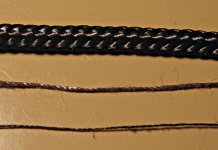
Nomad Z
Well-known
Yes, not sure how worn the lugs were when I got the M3 about 3 years ago, but to be honest think the rings from my current strap have done a lot of the damage I'm seeing at the moment, as there is a nice groove on the inside of each lug which each ring fits into nicely. Not worn completely through, but enough to make me feel cautious, and to find some sort of solution to the issue soon enough.
In any case, to illustrate the level of lug wear, a picture paints as they say..
(most of the wear is on the front of the lug, as per the picture below)
Lug Image.jpg by Murchú, on Flickr
I don't think I'd be happy with that. I would definitely be getting prices, now, for replacing them, and with something like stainless steel rather than chromed brass. All with a view to getting it done sooner rather than later (regardless of whether it needs a service).
Murchu
Well-known
I don't think I'd be happy with that. I would definitely be getting prices, now, for replacing them, and with something like stainless steel rather than chromed brass. All with a view to getting it done sooner rather than later (regardless of whether it needs a service).
Well, most of the wear is at the front, so plenty of the lug left aside from that, as what you are seeing is pretty much all the wear and what you can imagine just under the part of the wear that is showing. Enough to make me cautious in any case, thus this thread and the other
Roger Hicks
Mentor
Paracord isn't thread - it's 3mm in diameter and has a breaking strain of around 500kg. If the lugs were cutting into it, there will be loads of fluffy fibres around the lugs long, long before it's about to break.
In the photo below, from the top down, paracord, ultra strong thread, conventional sewing thread.
View attachment 91912
Fair enough, and thanks for the illustration. But I still think there's a lot of faith and opinion involved in either argument.
Isn't 2x 3mm (2x 1/8 inch = 1/4 inch) a tight fit through a strap lug? Or how else do you feed it through? (Not arguing --- pure ignorance on my part).
Cheers,
R.
Nomad Z
Well-known
Fair enough, and thanks for the illustration. But I still think there's a lot of faith and opinion involved in either argument.
I tend to agree. I don't have direct experience of how this would work long term with a camera, but I offer the following...
If you're familiar with Swiss Army Knives, you'll know that they have a little loop with a split ring attached, supposedly for use as a key ring. I got a Champion model years ago, and put a short bit of cord through the split ring so that it would be easier to pull it out of my pocket (I wore jeans back then, and the pockets were fairly tight - the end of the cord was just at the top of the pocket). Afer a few months, I noticed that the little loop on the frame of the knife was wearing away. It had reached the point where the metal had fractured at the thinned part. I squeezed the two sides together to reduce the chance of the split separating and put some thin nylon cord through it (200lb cord, doubled).
You can see how it has fared in the picture below...
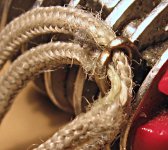
The dark line across the metal loop is the fracture. One part of the cord has almost completely worn through - that part has taken all the abrasion from the metal, while the other part behind it is intact. That bit of cord has been on there for 30 years, and the knife was in constant daily use for all of that time (until I retired it a couple of months ago and treated mysel to a shiny new Swiss Champ).
So, not a camera, and maybe not always pulled out of the pocket by the cord, but it has certainly had its share of wear and tear over the years.
Isn't 2x 3mm (2x 1/8 inch = 1/4 inch) a tight fit through a strap lug? Or how else do you feed it through? (Not arguing --- pure ignorance on my part).
A single piece of the paracord goes through, Roger. The hole in the lug is just big enough. Cord has a core of straight fibres, around which the outer is woven. If the ends aren't melted, the core can be pulled out to leave the woven tube of fibres. This tube can be doubled and will pass through. However, you can't do the loop thing where the bight goes through and the rest is passed through the bight and the whole pulled tight. Rather, you can do it at one end, but not at both ends. That's why the straps that use that attachment method have those dodgy quick release things - you do the bight/loop with each end and then attach the strap. With a single piece strap, that option isn't available, so putting a doubled part of the cord through doesn't gain anything.
awslee
Well-known
The Luigi leather strap works really well for me and it looks great!!!
paulfish4570
Mentor
nice job, nomad ...
sebastel
coarse art umbrascriptor
i like my shoelace.
Share:
-
This site uses cookies to help personalise content, tailor your experience and to keep you logged in if you register.
By continuing to use this site, you are consenting to our use of cookies.

